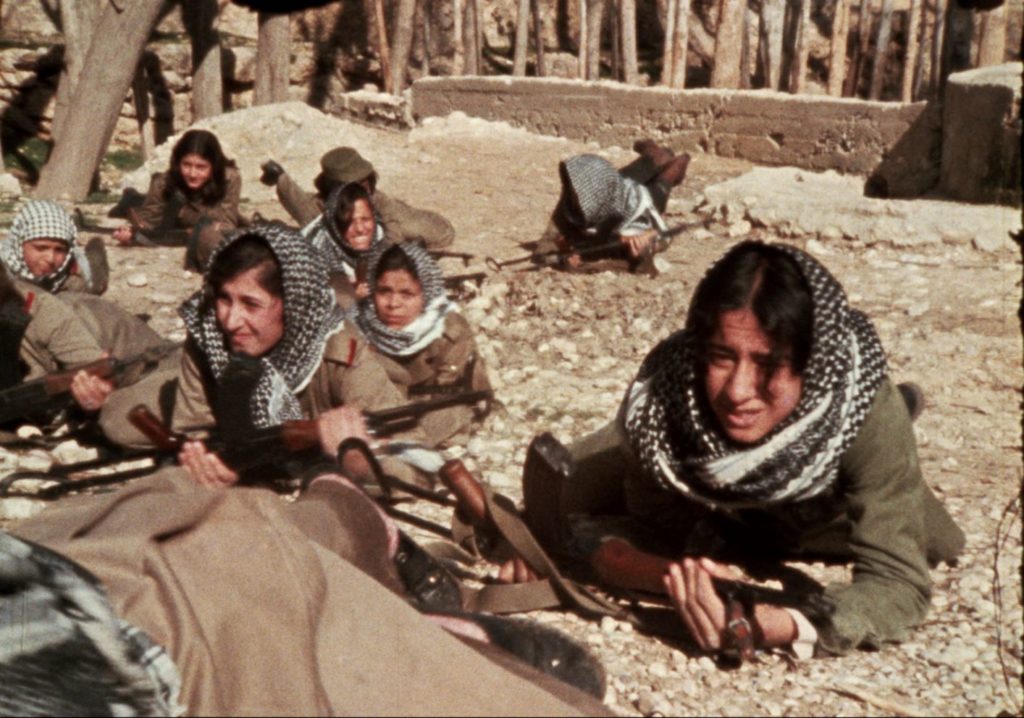This post is also available in: Français (French) العربية (Arabic)
It will come as no surprise that the short by Lebanese director Jocelyne Saab on Palestinian women and militants, filmed around forty years ago, was especially featured in the 27/20 Festival programming, which was given the slogan “borderland en mouvement, dignité en action.”
The event was held from the 24th till the 28th of January at the L'Art Rue headquarters, in the heart of the Medina of Tunis. It was born out of the Lina Ben Mhenni feminist school, which was founded four years ago. A committed journalist and blogger and a passionate feminist, Ben Mhenni played a key role in the 2011 Tunisian Revolution. The young woman left us on January 27, 2020—the date from which the festival takes its name.
With songs, poetry, theater, installations, photo exhibitions, debates, and more, this initiative presented an interdisciplinary artistic and activist lens through which to view, hear, think about, and defend border communities that have been rendered invisible. “Today,” the festival pamphlet read, “Gaza is a gaping wound that will forever remain open. We stand in solidarity with the Palestinian cause and recognize how central this struggle is to all just causes, particularly mobility, the preservation of land and its history, and the inalienable quest for freedom.”
Palestinian women have been, in addition to everything else, made invisible, and yet they took up arms to take back their land after the two great exoduses of their people. 1948: the year of the Nakba, the partition of Palestine, and the creation of the State of Israel. 1967: the Six-Day War and Israeli annexation of the West Bank.
Jocelyne Saab has strived, throughout her work, to fight against the amnesia of war. In this short, she gives voice to Palestinian women who try, at all costs, to keep their homeland alive by educating, campaigning, and resisting. We see them on the ground, in fatigues; it’s 1973: “Recently, women have started to join the fedayeen in their military actions. Volunteers, some as young as 15, these women undergo intensive, two-to-three-month training every year,” we learn.
The young women filmed by the director are mostly refugees and have experienced the devastation of exile. Yet each story is unique, like this 24-year-old girl with a degree in economics who is going to take an active part in Palestinian political and trade union life. She was sixteen when she fled across the Allenby Bridge. A refugee in a camp in the eastern suburbs of Beirut, she deplores the conditions she is living in, the lack of water, light, and hygiene. She remembers a chaotic academic past. Yet she chooses to continue to live in the camp: “The residents of the camp are like my family,” she explains. “I’ve completed my studies and can help in many ways; I can teach other women to read and write…”
At the beginning of the 1970s, Palestinian women seemed divided over the role of the armed struggle. Many of them wanted to believe in a political solution, but others were strong in their conviction and fully committed to armed struggle: “We are carrying out suicide operations while they attack us with American and French planes (…) There will be no political solution, there will only be Palestine,” one of the women freedom fighters exclaims, rifle in hand.
The last testimony is particularly trying: “Palestinian women are oppressed on the national level; they have been uprooted. They are also socially oppressed on account of their feminine condition. It is only through armed struggle and revolution that they can liberate themselves socially and economically,” a young woman states, her gaze stoic in the face of all the ordeals she had to endure. “I’ve carried out several operations in occupied territories. I distributed secret missives to revolutionaries. I secured their base. I hid them in my house, which the Israelis blew up. I distributed political leaflets to prisoners. I also photographed strategic positions. I suffered the worst abuse in their prisons, where I was locked up four times… That’s when I was accused of being part of the Popular Front for the Liberation of Palestine. The Israelis unleashed their dogs on me, beat me violently, hung me on a rope, gave me electric shocks and even forced me to lick the toilets.”
“It was absolutely necessary to show a new image, another image of the war.”
Jocelyne Saab refused to film the raw violence of the war. She instead wanted to “get off the beaten path of film writing” to restore the Israeli-Palestinian conflict to its true complexity. She does this through the stories of these women, as they speak about their different paths: “It was absolutely necessary to show a new image, another image of the war. It was not simply a matter of throwing an image out to the viewer like we do today, throwing an image of violence that confuses viewers and makes them not know where to stand. On the other hand, when we offer an image, even a very personal one… if it is thought out, if it speaks to people’s emotions, to the pain of others, it allows us to situate ourselves, to know where to place ourselves.”
The short, originally ordered by French TV (Antenne 2), was censored at the editing stage and was never broadcast on French channels. In Tunis, where it was being screened forty years later, the cries of young women rose from the heart of the Medina for Palestine.
For further information:
Watch the Palestinian Women short
Watch the TV5 Monde program dedicated to Jocelyne Saab
Read the interview with Mariam Abu Daqqa, former Palestinian fighter, published on Medfeminiswiya.
